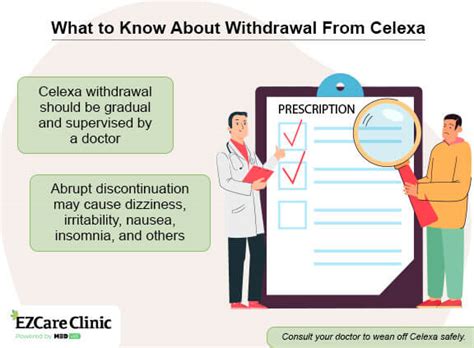Intro
Discover Celexa antidepressant side effects, including withdrawal symptoms, dosage risks, and interactions, to manage depression and anxiety safely with this SSRI medication.
The use of antidepressants has become increasingly common in modern society, with millions of people relying on these medications to manage their mental health. One such medication is Celexa, a selective serotonin reuptake inhibitor (SSRI) used to treat depression, anxiety disorders, and other conditions. While Celexa can be an effective treatment option for many individuals, it is essential to be aware of the potential side effects associated with its use. In this article, we will delve into the world of Celexa, exploring its benefits, working mechanisms, and the possible side effects that users may experience.
Celexa, also known by its generic name citalopram, is a prescription medication that has been widely used since its introduction in the 1990s. It works by increasing the levels of serotonin in the brain, a neurotransmitter that helps regulate mood, appetite, and sleep. By balancing serotonin levels, Celexa can help alleviate symptoms of depression, anxiety, and other mental health conditions. However, like any medication, Celexa is not without its potential drawbacks. Users may experience a range of side effects, from mild and temporary to more severe and long-lasting.
The importance of understanding Celexa's side effects cannot be overstated. By being aware of the potential risks and benefits associated with this medication, individuals can make informed decisions about their treatment and take steps to minimize any adverse effects. In the following sections, we will explore the various aspects of Celexa, including its benefits, working mechanisms, and the possible side effects that users may encounter. Whether you are considering Celexa as a treatment option or are already taking the medication, this article aims to provide you with a comprehensive understanding of this antidepressant and its potential impact on your life.
Celexa Benefits and Working Mechanisms

The benefits of Celexa are numerous, and the medication has been shown to be effective in various clinical trials. Some of the key benefits of Celexa include:
- Improved mood and reduced symptoms of depression
- Reduced anxiety and fear
- Enhanced sleep quality
- Increased appetite and energy levels
- Improved cognitive function and concentration
How Celexa Works
Celexa works by selectively inhibiting the reuptake of serotonin in the brain, which increases the levels of this neurotransmitter in the synaptic cleft. This increase in serotonin levels helps regulate mood, appetite, and sleep, and can help alleviate symptoms of depression and anxiety. The medication is typically taken orally, and its effects can be felt within a few weeks of starting treatment.Celexa Side Effects

In addition to these common side effects, Celexa can also cause more severe and long-lasting side effects, such as:
- Suicidal thoughts or behaviors
- Serotonin syndrome (a potentially life-threatening condition caused by excessive levels of serotonin in the body)
- Increased risk of bleeding or bruising
- Changes in appetite or weight
- Sexual dysfunction or decreased libido
Less Common Celexa Side Effects
Some less common side effects of Celexa include: * Allergic reactions, such as hives or itching * Changes in vision or hearing * Increased heart rate or blood pressure * Seizures or convulsions * Abnormal liver function or liver damageIt is essential to note that not everyone who takes Celexa will experience side effects, and the severity and frequency of side effects can vary widely from person to person. If you are taking Celexa and experience any side effects, it is crucial to consult with your healthcare provider to determine the best course of action.
Celexa Interactions and Warnings

In addition to these interactions, Celexa can also have warnings and precautions, such as:
- Increased risk of suicidal thoughts or behaviors in children and adolescents
- Potential for serotonin syndrome or neuroleptic malignant syndrome
- Increased risk of bleeding or bruising
- Potential for changes in appetite or weight
- Risk of withdrawal symptoms when stopping treatment
Celexa Dosage and Administration
Celexa is typically taken orally, once daily, with or without food. The recommended dosage of Celexa varies depending on the condition being treated, as well as the individual's age and medical history. Some common dosages of Celexa include: * 20 mg per day for depression * 10-20 mg per day for anxiety disorders * 20-40 mg per day for OCDIt is essential to follow the recommended dosage and administration instructions for Celexa, as taking too much or too little of the medication can increase the risk of side effects or reduce its effectiveness.
Celexa Alternatives and Treatment Options

In addition to these alternatives, other treatment options for depression and anxiety include:
- Psychotherapy, such as cognitive-behavioral therapy (CBT) or interpersonal therapy (IPT)
- Lifestyle changes, such as regular exercise, healthy eating, and stress management
- Alternative therapies, such as acupuncture or herbal supplements
Celexa and Pregnancy
Celexa can be used during pregnancy, but it is essential to consult with a healthcare provider to discuss the potential risks and benefits. Some studies have suggested that Celexa may increase the risk of birth defects or other complications during pregnancy, while others have found no significant risks. If you are pregnant or planning to become pregnant, it is crucial to discuss your treatment options with your healthcare provider.Celexa Withdrawal and Discontinuation

To minimize the risk of withdrawal symptoms, it is essential to taper off Celexa gradually, under the guidance of a healthcare provider. Some tips for discontinuing Celexa include:
- Gradually reducing the dosage over a period of weeks or months
- Monitoring for withdrawal symptoms and adjusting the taper schedule as needed
- Considering alternative treatments or therapies to manage symptoms during the taper process
Celexa and Weight Gain
Celexa can cause changes in appetite or weight, especially during the initial stages of treatment. Some individuals may experience weight gain, while others may experience weight loss. If you are taking Celexa and are concerned about weight gain, it is essential to discuss your concerns with your healthcare provider. Some tips for managing weight gain while taking Celexa include: * Eating a healthy and balanced diet * Engaging in regular exercise or physical activity * Monitoring weight and adjusting treatment as neededCelexa and Sexual Dysfunction

Celexa and Anxiety
Celexa can be used to treat anxiety disorders, including generalized anxiety disorder (GAD), panic disorder, and social anxiety disorder. The medication works by increasing the levels of serotonin in the brain, which helps regulate mood and reduce anxiety symptoms. If you are taking Celexa for anxiety, it is essential to work closely with your healthcare provider to monitor your symptoms and adjust treatment as needed.Celexa and Depression

Celexa and OCD
Celexa can be used to treat obsessive-compulsive disorder (OCD), a condition characterized by recurring and intrusive thoughts or compulsions to perform specific rituals or behaviors. The medication works by increasing the levels of serotonin in the brain, which helps regulate mood and reduce OCD symptoms. If you are taking Celexa for OCD, it is essential to work closely with your healthcare provider to monitor your symptoms and adjust treatment as needed.What is Celexa used for?
+Celexa is used to treat depression, anxiety disorders, and obsessive-compulsive disorder (OCD). It works by increasing the levels of serotonin in the brain, which helps regulate mood and reduce symptoms.
What are the common side effects of Celexa?
+Common side effects of Celexa include nausea, diarrhea, headache, dizziness, and fatigue. More severe side effects can include suicidal thoughts or behaviors, serotonin syndrome, and increased risk of bleeding or bruising.
Can Celexa be used during pregnancy?
+Celexa can be used during pregnancy, but it is essential to consult with a healthcare provider to discuss the potential risks and benefits. Some studies have suggested that Celexa may increase the risk of birth defects or other complications during pregnancy.
How long does it take for Celexa to start working?
+Celexa can start working within a few weeks of starting treatment, but it may take several months to reach its full effect. It is essential to work closely with a healthcare provider to monitor symptoms and adjust treatment as needed.
Can Celexa be used to treat anxiety?
+Yes, Celexa can be used to treat anxiety disorders, including generalized anxiety disorder (GAD), panic disorder, and social anxiety disorder. The medication works by increasing the levels of serotonin in the brain, which helps regulate mood and reduce anxiety symptoms.
As we conclude this article, we hope that you have gained a comprehensive understanding of Celexa, its benefits, and its potential side effects. Whether you are considering Celexa as a treatment option or are already taking the medication, it is essential to work closely with your healthcare provider to monitor your symptoms and adjust treatment as needed. If you have any questions or concerns about Celexa, we encourage you to reach out to your healthcare provider or a mental health professional for guidance and support. Additionally, we invite you to share your thoughts and experiences with Celexa in the comments below, and to share this article with others who may benefit from this information. Together, we can work towards a better understanding of mental health and the treatments available to manage it.
